
|
|
|
|
 |
|
Home Site Search Contact Us Subscribe
|
|
|
|
A New Yet Familiar Neighbor: Goldman School of Public Policy UC Berkeley by Architectural Resources Group
A new annex becomes a hands-on experience in preservation and urban design policy that garners neighborhood groups and local preservationists approval. by Kenneth Caldwell January 30, 2003 Architects often struggle
with making contemporary statements that respect older traditions. They argue
over whether their designs should speak to earlier buildings directly,
indirectly, or not at all. Communities that have lost historic buildings that
were significant either because of exceptional architecture (Penn Station, for
example) or popular sentiment (a favorite ice cream parlor) are concerned about
the loss of historic places and the addition of monstrosities that erase
collective memory. For projects at the University of California, Berkeley, in a
town of particularly outspoken citizens, the potential exists for an
architect’s nightmare – a project buried by committee. Over a century ago, an
iconoclastic architect named Ernest Coxhead came to California from England to
experiment with combining forms and materials in unexpected ways. An early commission
in the Bay Area was a fraternity house on the north side of the campus of the
University of California. He designed the large house so it appeared to be
several smaller structures, a sort of European village. Back then, the town
actually felt something more like the countryside. Over the years, a large
number of professors populated the neighborhood. Residential structures by
early Bay Region architects such as Bernard Maybeck and John Galen Howard
dotted the hills. Most of the fraternities ended up on the southeastern edge of
the campus, and in the late 1960s the School of Public Policy took up residence
in Coxhead’s quirky structure. By the middle 1990s, the nationally recognized
school needed to upgrade their beloved house and began a program of expansion. Architectural Resources
Group (ARG), a San Francisco firm with a specialty in historic preservation,
was hired to upgrade the landmark structure to meet current codes, including
seismic strengthening. Over the years, Coxhead’s unusual design had become a
little more mixed up, but ARG’s approach left the earlier renovations largely
intact. However, as part of the code upgrade project, the design team proposed
that the school develop a master plan for the site. It turned out that the
school had already envisioned a master plan, which ARG helped to complete,
involving an upgrade of the school’s physical facility and the design of a new
building. In the process of renovating Coxhead’s building, the architects had
learned how it was put together and how the school worked. Their sensitivity to
the historic and cultural aspects helped them develop a compatible design for
the annex. In the second half of the
20th century, several large structures were completed on the north side campus
and directly across Hearst Street, which formally divides the campus from the
city. Bruce Judd, FAIA, Principal-in-Charge for ARG says, “The campus had
spilled over its border, and not in the friendliest way. To the east and west,
our site was surrounded by some fairly imposing structures. Yet immediately to
the north were residential-scaled buildings and large oak trees. We understood
what kind of scale we should emulate. At the same time, the Goldman School
needed large classrooms and several offices. So there were a lot of tensions to
resolve.” One of the largest sources
of tension was the relationship between the university and the community and
preservation activists. Local opinion ranged from concerns over the
architectural expression to resistance to any new campus structure. The Goldman
School was in the unusual position of applying their teaching to expanding
their facility on campus. Judd continues, “The school trains students to
understand public policy. In this case, preservation and urban design policy
had to be broadly understood in order to bring the community on board. As the
School of Public Policy, they didn’t want to be the bully.” Only a surface
parking lot occupied the site of the proposed new structure, so no buildings
had to be demolished. But the always-vigilant Berkeley preservation community
expressed a lot of doubt. After many meetings with neighborhood groups and
local preservationists, a winning design emerged and threatened litigation was
withdrawn. But the process took several iterations. Placing the new building on
Le Roy Avenue meant that the new annex would not be physically connected to the
historic house. Separating the two structures allowed the designers to create a
distinct contemporary structure rather than an addition. “We consciously referred
to some of the forms that Coxhead used, especially his funny dormers and long
roof line, but we did not want to imitate his house,” comments Project Manager
Aaron J. Hyland. “We were creating a 13,000-square-foot classroom and an office
building that fits in between the large university and smaller scaled
residential structures. Instead of redwood shingles, which would be
prohibitively expensive, we used modern materials that met the budget – stucco
and concrete block. The variation can be found in the texture of the materials
and the forms of the building. We were not designing a large house – just a
building that would nestle in well. This is a subtle but important
distinction.” Inside this quiet building
are octagonal classrooms designed to encourage lively dialog. According to
Michael O’Hare, a professor at the Goldman School, who originally trained as an
architect and engineer and collaborated with ARG on the design, “Our students
are socialized to expect one-way interaction with a professor. The professor
knows true things and tells them, and then they write it down.” In contrast,
the instruction at the Goldman School is highly interactive and case-based. The
students are given problems and resources to work on together. According to
O’Hare, “The students need to see each other’s faces and know each other’s
names.” This is the reason for the tiered design, the slots for name cards, and
the egg-shaped seating arrangement. O’Hare expects the classrooms to reinforce
the schools preferred teaching style and help students adapt quickly and use it
productively: “The architecture is especially important to overcome the habit
of being told stuff in a lecture arrangement.” Certain traditional tools of
classroom design, such as a blackboard and screen, are placed at the open end
or front of the classroom. Judd comments, “It is a
wonderful irony that we ended up with a building that is fairly subdued on the
outside, but encourages lively debate on the inside.” In addition to two large
classrooms that can hold over 100 students each, there are 12 faculty offices,
as well as computer labs. The school also wanted some kind of center, or heart,
where debate could be fostered. Building the new structure at the site’s
western edge permitted a new courtyard to be constructed between the historic
and new buildings. In Berkeley’s moderate climate, this outdoor space is now
used for classes, special events, and the spontaneous interaction that is
essential to campus life. Judd, who went to school at UC Berkeley, remembers,
“Even though several large buildings interrupted the original campus plan,
there are dozens of delightful spaces under a tree where you could study, nap,
or argue. Respecting the landscape tradition is as important as respecting
Coxhead’s architectural tradition. Most importantly, we engaged in a lively
public debate to get here. Another fine Berkeley tradition!” Sometimes a lot of
noise results in something quite subtle and wonderfully familiar. Client: Goldman School of Public Policy, University of California,
Berkeley Building Committee: Michael Nacht, Dean; Michael O'Hare,
Professor; John Ellwood, Professor; Sandra Keptchel, Business Officer Planning Design and Construction: University of California,
Berkeley; Stan Mar, Project Manager; Gary Giglio, Project Superintendent Environmental Planning: University of California, Berkeley;
David Duncan, Ephraim Levy, Senior Planners Architect: Architectural Resources Group, San Francisco Design Team: Principal: Bruce Judd, FAIA (Principal), Aaron
Jon Hyland, AIA (Project Manager), Philip Rossetti (Project Designer), Zimei
Yang, Pam Brown, Michelle Dryness (Project Team) Structural Engineer: GFDS, San Francisco Landscape
Architect: Pattillo & Garrett, Oakland Mechanical
Engineer: Guttman & Blaevoet, San Francisco Contractor: BBI Construction, Oakland Electrical
Engineer: Pete O. Lapid Associates Audio-Visual: Shen Milsom & Wilke/Paoletti Photography: David Wakely
Photography Architectural Resources Group,
Architects, Planners & Conservators, Inc., is a San Francisco-based
architecture and historic preservation firm founded in 1980. The firm had been
responsible for the adaptive reuse and seismic strengthening of existing
structures, the documentation and restoration of historic properties, and the
design of new structures that fit into historic surroundings. Well known
projects include the Conservatory of Flowers in San Francisco's Golden Gate
Park, the Filoli Estate and Visitor's Center in Woodside, and the Language
Center at Stanford University. Kenneth
Caldwell is a communications consultant and writer based in Oakland,
California. |
(click on pictures to enlarge) 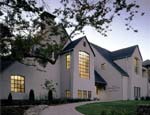 (David Wakely) Courtyard entrance to the new Goldman School of Public Policy annex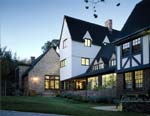 (David Wakely) The existing (quirky) Ernest Coxhead-designed building faces the new annex across a courtyard.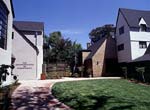 (David Wakely) The courtyard connecting the two buildings used to be a parking lot.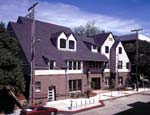 (David Wakely) New building facing Soda Hall on Le Roy Avenue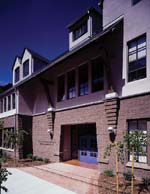 (David Wakely) Detail of Le Roy Avenue façade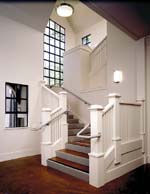 (David Wakely) Central staircase at second floor/courtyard level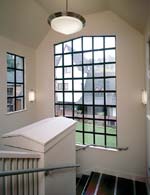 (David Wakely) View from staircase to courtyard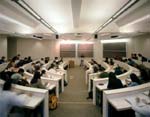 (David Wakely) Tiered oval-shaped classrooms create an interactive, collaborative learning environment.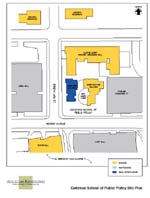 (ARG) Site plan: blue structure indicates new annex |
© 2003 ArchNewsNow.com